16 results
Common Core RST.9-10.9 scaffolded notes
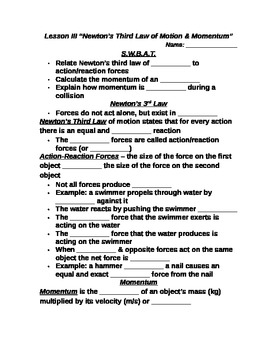
Lesson III Student PowerPoint Note Guide "Newton's Third Law & Momentum"
This lesson aligns with the Common Core State Standards:
"STANDARD 6 - Force and Motion
The competent science teacher understands and applies the concepts that describe force and motion and the principles that explain them.
6B. understands the concepts and interrelationships of force (including gravity and friction), inertia, work, power, energy, and momentum
6G. describes the effects of gravitational, electromagnetic, and nuclear forces in real life situations."
Student note guide or "fill in
Subjects:
Grades:
7th - 9th
CCSS:

Lesson II Student PowerPoint Note Guide "Newton's 1st and 2nd Laws"
This lesson aligns with the Common Core State Standards:
"STANDARD 6 - Force and Motion
The competent science teacher understands and applies the concepts that describe force and motion and the principles that explain them.
6B. understands the concepts and interrelationships of force (including gravity and friction), inertia, work, power, energy, and momentum
6G. describes the effects of gravitational, electromagnetic, and nuclear forces in real life situations."
Student note guide "fill i
Subjects:
Grades:
7th - 9th
CCSS:
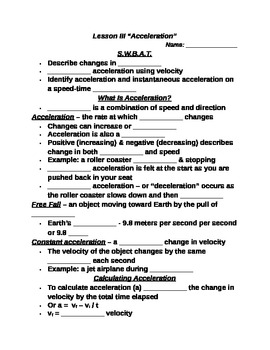
Lesson III Student PowerPoint Note Guide "Acceleration"
This lesson aligns with the Common Core State Standards:
"STANDARD 6 - Force and Motion
The competent science teacher understands and applies the concepts that describe force and motion and the principles that explain them.
6A. understands the concepts and interrelationships of position, time, velocity, and acceleration.
6E. describes and predicts motions of bodies in inertial and accelerated frames of reference and in one and two dimensions in a physical system with association to the basic
Subjects:
Grades:
7th - 9th
CCSS:
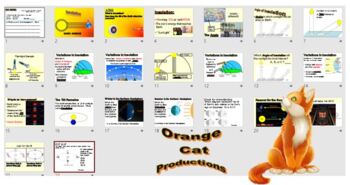
THE ULTIMATE INSOLATION LESSON POWERPOINT
If you have an observation, this mini-lesson will impress your principal. The 23 PowerPoint slides are just the right amount for the mini-lesson part of your entire lesson. Every slide contains samples from songs, movies, television, and/or sound effects. The transitions between slides all have animations as well as the pictures and words on each slide. Your Students will love the music and sound bytes. There is a DO NOW included (with content-appropriate music in the background), AIM
Subjects:
Grades:
6th - 12th
CCSS:
NGSS:
HS-ESS1-4
, MS-ESS1-2
, HS-ESS1-3
, HS-ESS1-1
, MS-ESS1-1
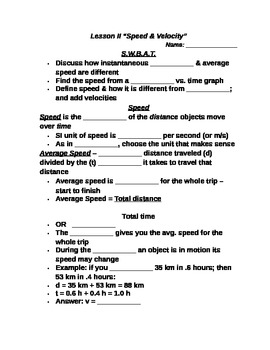
Lesson II Student PowerPoint Note Guide "Speed and Velocity"
This lesson aligns with the Common Core State Standards:
"STANDARD 6 - Force and Motion
The competent science teacher understands and applies the concepts that describe force and motion and the principles that explain them.
6A. understands the concepts and interrelationships of position, time, velocity, and acceleration.
6E. describes and predicts motions of bodies in inertial and accelerated frames of reference and in one and two dimensions in a physical system with association to the basi
Subjects:
Grades:
7th - 9th
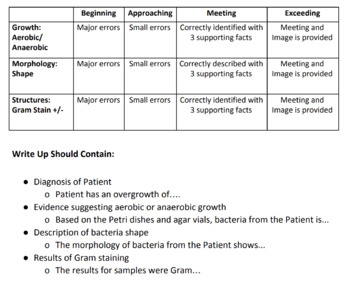
Bacterial Morphology, Gram Stain & Inoculation Exercise with RUBRIC
A great multi-day project analyzing bacterial samples!! Great for the end-of-unit assessment or application of skill investigation. Students should have an understanding of gram staining, bacteria morphology, and the difference between aerobic and anaerobic growth patterns. Students conduct independent research on key differences between B. subtilis and E. coli using the provided graphic organizer. Then, innoculate Petri dishes and vials with the sample provided by the teacher. Through growth, g
Subjects:
Grades:
10th - 12th
CCSS:
NGSS:
HS-LS2-3
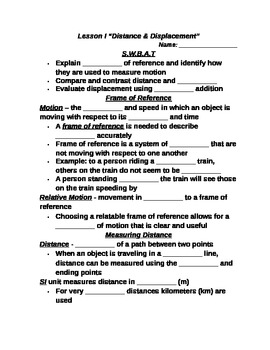
Lesson I Student PowerPoint Note Guide "Distance and Displacement"
This lesson aligns with the Common Core State Standards: "STANDARD 6 - Force and Motion The competent science teacher understands and applies the concepts that describe force and motion and the principles that explain them. 6A. understands the concepts and interrelationships of position, time, velocity, and acceleration. 6E. describes and predicts motions of bodies in inertial and accelerated frames of reference and in one and two dimensions in a physical system with association to the basic th
Subjects:
Grades:
7th - 9th
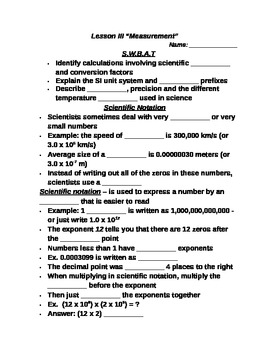
Lesson III Student PowerPoint Note Guide "Measurement"
This lesson aligns with the Common Core State Standards (CCSS):
"STANDARD 1 - Science as Inquiry
The competent science teacher understands scientific inquiry and has the ability to conduct scientific inquiry. 1A.understands assumptions, processes, purposes, requirements, and tools of scientific inquiry. 1E. applies mathematical and statistical methods to collect, analyze, and communicate results of investigations. 1G. uses evidence and logic in developing proposed explanations that address scien
Subjects:
Grades:
7th - 9th
CCSS:
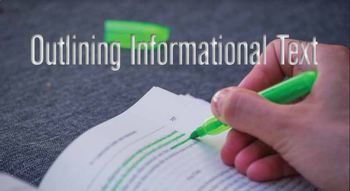
Outlining Content Information Resource (Making Outlines of Text)
In the age of the internet, students need skills for acquiring and criticizing information from media. This product is a trove of outlining resources offered by the author of this publication on outlining.Trove includes: rubrics, presentations, samples, computer shortcut tips, and tutorials.
Grades:
7th - 12th, Higher Education, Adult Education, Staff

Lesson II Student PowerPoint Note Guide "Using a Scientific Approach"
This lesson aligns with the Common Core State Standards (CCSS): "STANDARD 1 - Science as Inquiry
The competent science teacher understands scientific inquiry and has the ability to conduct scientific inquiry. 1A.understands assumptions, processes, purposes, requirements, and tools of scientific inquiry. 1C. understands different approaches to conducting scientific investigations."
Student note sheet that goes with the PowerPoint lesson II in the "Science Skills" unit - introductory physics. T
Subjects:
Grades:
7th - 9th
CCSS:
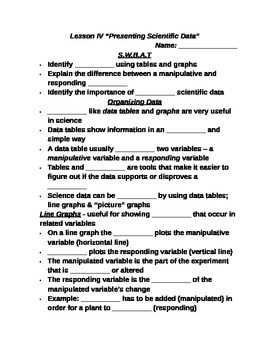
Lesson IV Student PowerPoint Note Guide "Presenting Scientific Data"
This lesson aligns with the Common Core State Standards (CCSS):
"STANDARD 1 - Science as Inquiry
The competent science teacher understands scientific inquiry and has the ability to conduct scientific inquiry. 1A.understands assumptions, processes, purposes, requirements, and tools of scientific inquiry. 1E. applies mathematical and statistical methods to collect, analyze, and communicate results of investigations. 1G. uses evidence and logic in developing proposed explanations that address sci
Subjects:
Grades:
7th - 9th
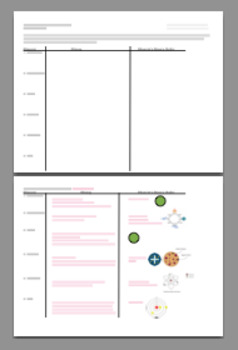
Development of the Atomic Theory - Pair Activity (or Note Sheet) - W/ Answer Key
Think-Pair-Share Activity (Can also be used individually as a note taking sheet during lesson presentation)
Students are engaged in their learning while assessing themselves and their partners as they move around the room discussing the atomic theories and atomic models that led to today's modern atomic theory/model. The students work in pairs and are timed. This is meant to be a quick assessment activity following the teacher's lecture. This can then be followed up using our fill-in the bla
Subjects:
Grades:
7th - 11th
Types:
CCSS:
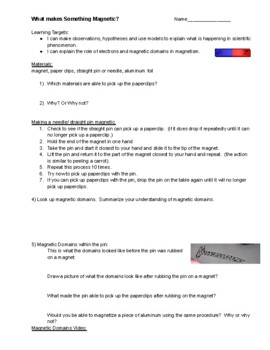
Magnetic Domain Lab Activity and Video Guided Notes - Inquiry
Students are encouraged to question what really makes something magnetic by conducting a series of investigations. First students check which supplies are able to pick up a paperclip. After realizing that indeed the straight pin (or sewing needle) is not magnetic, they then follow a procedure to turn the pin into a temporary magnet. This causes students to realize magnetism is not an inherent characteristic of materials but there is something else going on. Students then watch a video and ta
Subjects:
Grades:
8th - 10th
CCSS:
NGSS:
HS-PS2-5
, MS-PS2-3
, MS-PS2-5

The Solution to Pollution
After instructor presents the PowerPoint on marine debris and disposable culture, students examine and discuss data from the Environmental Protection Agency’s Waste Report from 2012 (also included in PowerPoint). After gaining a better understanding of types and volumes of waste discarded in the U.S. and how much of that is recovered, students get into groups and create a Public Service Announcement (PSA) designed to educate the public about single-use plastics and mitigating marine debris. The
Subjects:
Grades:
9th - 12th
CCSS:
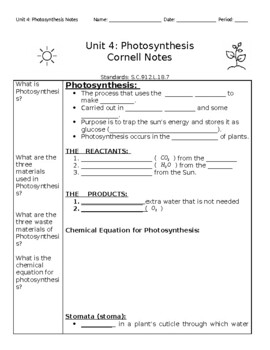
Photosynthesis Modified Cornell Notes
This note packet is designed for students to understand concepts, properties, reactants, and products of photosynthesis.
Grades:
10th - 12th
CCSS:
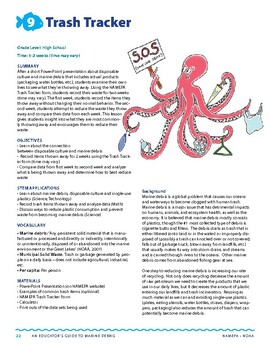
Trash Tracker
After a short PowerPoint presentation about disposable culture and marine debris that includes actual products (packaging, water bottles, etc.), students examine their own lives to see what they’re throwing away. Using the NAMEPA Trash Tracker form, students record their waste for two weeks (time may vary). The first week, students record the items they throw away without changing their normal behavior. The second week, students attempt to reduce the waste they throw away and compare their data
Subjects:
Grades:
9th - 12th
CCSS:
NGSS:
HS-ESS3-4
, HS-ETS1-1
Showing 1-16 of 16 results

